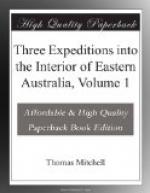We continued along an undulating ridge for about five miles, crossing also a flat on which all the trees, for a considerable extent, had been laid prostrate by some violent hurricane, making a very uncommon opening in the forest through which we were accustomed to travel. The trunks lay about due east, and all nearly parallel; thus recording a storm from the west before which our tents must have gone like chaff before the wind, and where shelter from the trees, not under them, might have been sought for in vain.
At 7 1/2 miles we crossed a chain of small ponds falling to the north (probably Coysgaime’s ponds of Oxley) and about one mile further we ascended the northern shoulder of the hill I was in search of. From the summit I obtained angles on one or two hills to the south, which lay a few miles off, but I could not recognise them as having been previously intersected.
We descended and proceeded northward through the dense woods, in the midst of which, after estimating distances and time, I at length pulled my rein, and observed to Mr. Cunningham that I hoped to fall in with Mr. Larmer, or the track of the carts thereabouts.
ENCAMP WITHOUT WATER.
Just then I heard the crack of a whip, and we soon met Mr. Larmer at the head of the party. I continued the route in the same direction until after sunset, when we were obliged to encamp without reaching water. Bulger however, with the assistance of the natives, found some, after the rising of the moon, but not until he had been nearly three miles to the northward in search of it. The cattle could not be watered there that night as they had already travelled upwards of 15 miles.
I was aware that I might have made the Bogan by proceeding more towards the north; but I preferred the direct line of route, even at the risk of encountering a scarcity of water. In the more northerly course we should have entered a great bight of that river, whereas I was making for its most southern bend, which was not only in the most direct line towards Oxley’s Tableland, but was also nearer the hills along which I was desirous of working my survey.
April 17.
ROCKS OF BENY.
We moved off at 8 o’clock, and at the distance of 3 1/4 miles we came upon some curious rocks of red sandstone, forming the tops of a ridge which extended North-North-East.
It is called Beny by the natives, and in a deep crevice there is a well, the water of which, although at times apparently deep, had the previous night been drained nearly to the bottom by a party of some tribe whose fires still were burning.
NATIVES LEAVE THE PARTY.
The natives who accompanied us examined the traces of those who had fled with considerable interest, and then fell behind our party and disappeared.
From the highest of these rocks I obtained some good angles and bearings on the hills I had seen on the day previous, and also on some of the loftiest summits of Harvey’s range.




